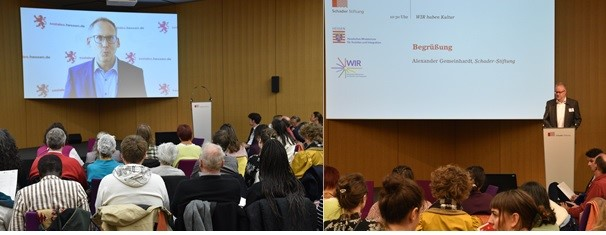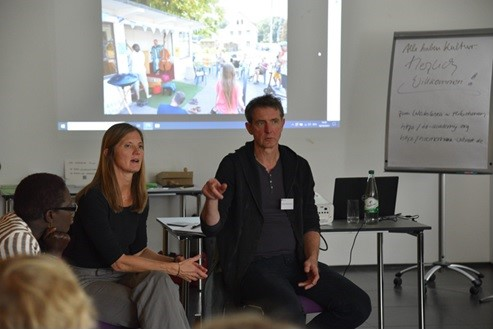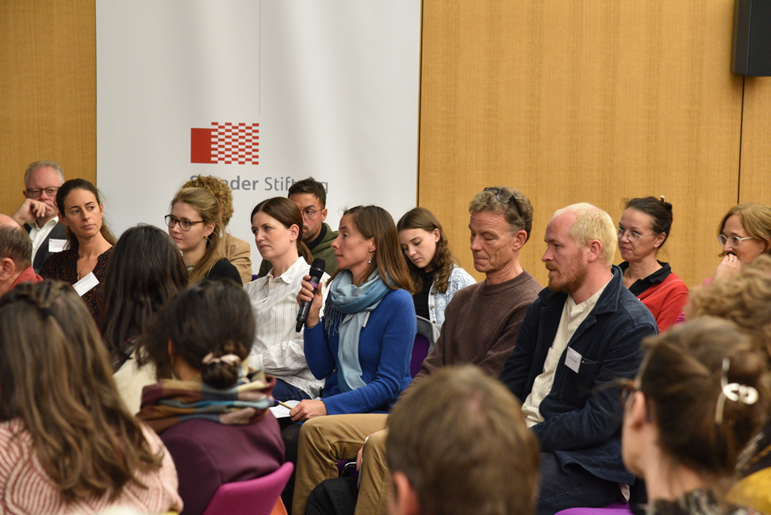Documentation of the workshop on 18 October 2023 from 14:00-16:00
Organiser: Öko-Institut e.V., tdAcademy, thematic line 4 "Formats" (B. Brohmann, M. Mbah) in cooperation with Hoernemann & Walbrodt (J. Hoernemann, Walbrodt, Bonn)

Figure 1: Welcome notes by the Hessian Minister of Social Affairs Kai Klose & Alexander Gemeinhardt from Schader Foundation, Schader Foundation 2023
Background and procedure
By presenting three very different participatory approaches to art and culture, the aim was to work out - together with the workshop participants - the special features and commonalities of local and regional art and culture formats. In line with the conference's overarching questions about the visibility and tangibility of local offerings and the conditions for cultural participation, we wanted to discuss the goals and accessibility of activities specifically designed for different spaces and target groups with artists, academics and cultural practitioners. The main focus of interest was on questions of initiation, necessary framework conditions and possible participation options.
The exchange of experiences on three specific projects was to be deepened:
- a municipal approach (AExpertirience, Samtgemeinde Wathlingen), which opens up new and surprising perspectives on administration and its processes through invitations and activities in previously "art-averse" spaces;
- a regional approach (Innehaltestellen/Land und Kultur gestalten Dresden-Nossen), which uses the revitalisation of (abandoned) bus stops to develop small cultural spaces designed by citizens themselves, and
- a school-based approach (Kreativität in Zwischenräumen, IGS Bonn), which artistically accompanied the everyday lives of pupils at an integrated comprehensive school for over a year.
Workshop procedure
The two-part workshop comprised the following steps:
Part 1 on local and regional experiences:
- Welcome and brief introduction (sociogram)
- Input on the formats in the municipal and regional context incl. follow-up questions
- Moderated discussion with the initiators on specific individual aspects
- Discussion and exchange of experiences with all workshop participants
Part 2 on experience in the school context:
- Welcome and orientation (part 1)
- Input on the school format incl. follow-up questions
- Moderated discussion with the initiators on specific individual aspects
- Discussion in the group as a whole, bringing together the findings from all experiences as well as reasons and challenges in different contexts

Figure 2: Presenters of the Workshop (Hoernemann & Walbrodt) Schader Foundation 2023
Content focus and discussion
A central theme that underpins the three projects presented and linked the discussion in the workshop is the idea that art does not exclude, but on the contrary sees every person as an artist in their uniqueness, irrationality and responsibility (Walbrodt 2023). With their "instigation", the participating artists were concerned with overcoming their own limits (of perception, thoughts, alternative actions), trying things out (changes in behaviour) and thus also discovering a new reality (motivation) by connecting people in the potential space of art.
Discussion rounds on specific aspects
The municipal action in the joint municipality of Wathlingen with the temporary establishment of a "Basic Office for the Impossible", a "Studio for All" or the initiation of an "I-You-We-All" day combined various actions and locations. The workshop discussed what constituted the core of this artistic format and how the various steps/stations were selected. The artists first conducted preliminary research and interviews (together with scientists), on the basis of which an initial concept was developed. Residents were then confronted with surprising activities in places that were originally familiar to them (e.g. their former administration) or new places (construction trailer: a place to feel good) and motivated to participate. In the context of Wathlingen, sustainability issues were also addressed in particular. What interests citizens about their town and how they identify with the development there was collated.
https://hoernemann-walbrodt.de/aexpertirience/
Another approach was associated with the installation of art activities in (former) bus stops. The "Innehaltestellen" project also included very different activities with different objectives. The idea arose from a journey along a regional bus route that is only served to a very limited extent, but at the same time has striking converted bus stops that have great potential as locations for activities. As part of action days, the little houses were to be designed and utilised in new ways (e.g. through exhibitions, music, art events) and at the same time alternative mobility options were to be offered and tried out. The aim was also to create new social links between the individual villages in the district and to improve the visibility of committed groups and individuals. These aspects are also taken care of by a regional association (Landgestalten e.V.) with which the artists cooperated and which was able to arrange further contacts as part of its "Land und Kultur gestalten" projects - here a local mayor was won over as a central supporter, through whom the idea of the "Innehaltestellen" could also be perpetuated. In this way, it combines artistic interventions in public spaces with the creative commitment of village communities.
https://hoernemann-walbrodt.de/innehaltestellen-miteinanders/
The school approach "Art in Spaces" in an integrated comprehensive school in Bonn was based on the idea that creative interventions and artistic forms of expression can change the perception of space and thus also trigger changes in the users. Before lessons and during breaks, the artists visited the school's "public" spaces in order to first observe, react to what was there and try out different "alienations" through performances. The discussion in the workshop raised the question of change, i.e. could effects already be observed over the period of time and were the spaces seen anew by the users? The artists reported very positive reactions from the pupils, e.g. to being addressed directly and asked about their personal wishes or the personal morning greeting, while indirect addresses attracted attention but did not generate any explicitly positive feedback. This effect of direct perception and appreciation observed here was also shared by the experiences of other workshop participants.
https://hoernemann-walbrodt.de/kreativitaet-in-zwischenraeumen/
Results
The successful bringing together, integration and activation of people at the respective locations and events was formulated as a central "result" for the municipal and regional activities. On the one hand, the locations identified (in the municipal and regional area or in the school context) have very different starting conditions - and problem situations. On the other hand, the artistic work also combined similar "approaches" to address and involve passers-by, residents or pupils by creating surprising - unique - situations through supposedly familiar objects in new constellations (bus shelters with art, a school staircase with lunch boxes, a self-appointed municipal office with a stamp and certificate).
In all three contexts, the initial aim was to closely observe and perceive everyday situations and routines in order to redesign and experience them. Ideas for an impulse for change then emerged in each case: found objects or "unusual" places were taken up and reinterpreted and provided with new functions and opportunities for exchange and communication. According to the artists, a central aim was to enable communication under the three aspects of "uniqueness", "responsibility" and "irrationality".
In the context of school, the main aim was to record the processes of everyday school life, but also to familiarise themselves with the use of spatial situations and objects. Through creativity, the idea of intermediate spaces (and the potential for change) should take shape - and become visible and tangible for everyone. Pupils and teachers were involved in different ways over the course of the intervention. Schoolchildren were addressed indirectly and directly. Teachers and the school principal were involved in the planning of some of the activities.
The experiences and conditions for success from the school environment were shared by various workshop participants. They mentioned the great importance of an (artistic) view of the school as an institution from the outside and regretted that only a few schools were willing to engage in such cooperation. At the same time, the need to find "allies" within the institution and to strive for continuity for initiated changes was also mentioned. In this context - according to the artists' experience - the support of decision-makers from politics and administration was important.
Continuation, but also new projects, are always associated with the (not easy) search for funding, whereby reference was made to different programmes in individual federal states, but also to nationwide funding, e.g. from the Federal Agency for Civic Education.

Figure 3: Final discussion with the audience, Schader Foundation 2023
